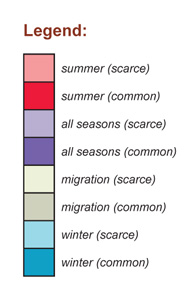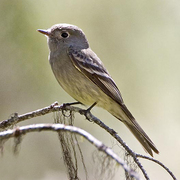Dusky Flycatcher
General Description
The Dusky Flycatcher is very similar in appearance to the Hammond's Flycatcher, with only a few subtle differences. Like other Empidonax flycatchers, the Dusky usually has two white wing-bars, a white eye-ring, olive upperparts, and yellowish-cream underparts. Dusky Flycatchers have longer tails and bills and shorter wings than the Hammond's. It is best to use range, habitat, and song, along with an advanced field guide, to identify this Empidonax group. The range of the Dusky Flycatcher overlaps with two other, closely related flycatchers (Gray and Hammond's). When the three species come into contact, they defend territories from one another and do not interbreed.
Habitat
In Washington, Dusky Flycatchers are found primarily in dry, open, conifer forests with a shrubby understory, Ponderosa pine, and clear-cuts. During migration they are less restricted than during the breeding season and can be found in brushy areas, along streams, and in shady, broadleaved woodlands. Look for them in the Ponderosa pine zone east of the Cascade crest, flying out from the low to middle branches.
Behavior
Dusky Flycatchers view their prey from exposed perches and fly out from the perch to catch the insects in the air. Sometimes birds hover near foliage or bark to catch flying insects. Occasionally they pounce on prey on the ground. Both Dusky and Hammond's Flycatchers flick their tails in an up-down motion, while the Gray Flycatcher flicks its tail down and then up. This behavior may help narrow down the choices when trying to distinguish between the Empidonax flycatchers.
Diet
Dusky Flycatchers catch insects in the air, perching on dead branches between foraging flights.
Nesting
Dusky Flycatchers nest in Ponderosa pine areas where there is dense cover above and below the nest. The nest is placed, on average, six feet above the ground, in an upright fork in a shrub or small tree. The female builds a cup-shaped nest of grasses and other fine plant material, animal hair, and feathers. As the female incubates four eggs, the male brings her food. Once the eggs hatch, both the male and the female feed the young. Nest-building and egg-laying can be delayed by inclement weather.
Migration Status
Dusky Flycatchers migrate to the southwestern United States and Mexico. During migration they are rarely seen passing through coastal Washington. In spring, males arrive on the breeding grounds about the second week of May and females a week later. By mid- to late August they are on their way south again.
Conservation Status
Dusky Flycatchers are relatively common throughout the western United States and Canada and appear to be faring well in general, perhaps due to forestry practices that thin stands and leave small forest openings. However, according to Breeding Bird Survey data, they have experienced a small, not statistically significant decline in Washington from 1966-2002.The species is particularly vulnerable to bad weather, consequently, a spring rain or snowstorm can kill an entire local breeding population.
When and Where to Find in Washington
Breeding populations can be found in the Blue Mountains, on the East Slope of the Cascades, and in the Spokane area. Migrants can be seen in the central Columbia Basin and along the west slope of the Cascades. Non-breeding birds have been reported in several low-lying locations west of the Cascades.
 Abundance
Abundance
| Ecoregion | Jan | Feb | Mar | Apr | May | Jun | Jul | Aug | Sep | Oct | Nov | Dec |
|---|---|---|---|---|---|---|---|---|---|---|---|---|
| Oceanic | ||||||||||||
| Pacific Northwest Coast | ||||||||||||
| Puget Trough | R | |||||||||||
| North Cascades | R | R | R | R | ||||||||
| West Cascades | U | U | U | U | ||||||||
| East Cascades | R | F | F | F | F | R | ||||||
| Okanogan | R | C | C | C | C | U | ||||||
| Canadian Rockies | F | F | F | F | ||||||||
| Blue Mountains | R | C | C | C | C | U | ||||||
| Columbia Plateau | F | F | F | F | F |
Washington Range Map

North American Range Map


Family Members
 Olive-sided FlycatcherContopus cooperi
Olive-sided FlycatcherContopus cooperi Western Wood-PeweeContopus sordidulus
Western Wood-PeweeContopus sordidulus Alder FlycatcherEmpidonax alnorum
Alder FlycatcherEmpidonax alnorum Willow FlycatcherEmpidonax traillii
Willow FlycatcherEmpidonax traillii Least FlycatcherEmpidonax minimus
Least FlycatcherEmpidonax minimus Hammond's FlycatcherEmpidonax hammondii
Hammond's FlycatcherEmpidonax hammondii Gray FlycatcherEmpidonax wrightii
Gray FlycatcherEmpidonax wrightii Dusky FlycatcherEmpidonax oberholseri
Dusky FlycatcherEmpidonax oberholseri Western FlycatcherEmpidonax difficilis
Western FlycatcherEmpidonax difficilis Black PhoebeSayornis nigricans
Black PhoebeSayornis nigricans Eastern PhoebeSayornis phoebe
Eastern PhoebeSayornis phoebe Say's PhoebeSayornis saya
Say's PhoebeSayornis saya Vermilion FlycatcherPyrocephalus rubinus
Vermilion FlycatcherPyrocephalus rubinus Ash-throated FlycatcherMyiarchus cinerascens
Ash-throated FlycatcherMyiarchus cinerascens Tropical KingbirdTyrannus melancholicus
Tropical KingbirdTyrannus melancholicus Western KingbirdTyrannus verticalis
Western KingbirdTyrannus verticalis Eastern KingbirdTyrannus tyrannus
Eastern KingbirdTyrannus tyrannus Scissor-tailed FlycatcherTyrannus forficatus
Scissor-tailed FlycatcherTyrannus forficatus Fork-tailed FlycatcherTyrannus savana
Fork-tailed FlycatcherTyrannus savana

